Isis, Flint Knives, Mooring Posts & Stars
Part 2
Last time we saw how the ancient Egyptian constellation of Iset Reret—in Her upright-hippopotamus-with-a-crocodile-on-Her-back form—was envisioned as using a flint mooring post and golden chains to keep the constellation of the Foreleg of Set in its proper place in the heavens.
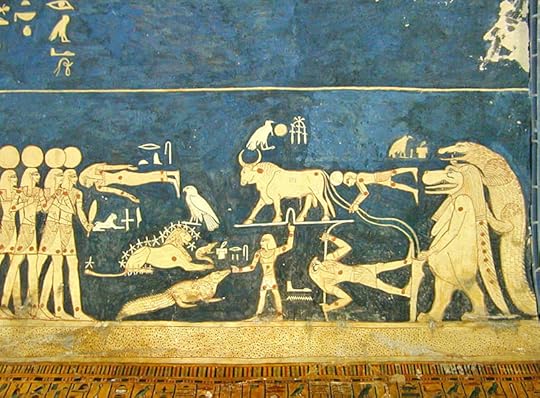 The mooring post secures the stars
The mooring post secures the starsThis time we’ll look into the symbolism more deeply and then see how we could use this information in spiritual and magical Work with Isis.
The Mooring Post
In case you’re not a sailor, a mooring post is a sturdy post to which you can tie your boat to keep it in one place, i.e. moored. You might find them on a dock, or if you were an ancient Egyptian, driven into the banks of the Nile river.
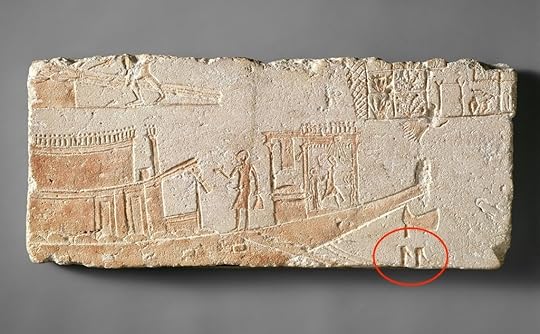 A royal barge moored by twin mooring posts, circled in red
A royal barge moored by twin mooring posts, circled in redJust as mooring posts were common in ancient Egyptian daily life, so they were important in the afterlife. The deceased traveled through the Otherworld by boat, and secured their boats in their final destinations by means of a mooring post. In the Coffin Texts, the deceased declares that “my boat shall be brought to me, the mooring post shall be driven in for me.” Because of the importance of the mooring post in this context, “coming to moor” became an Egyptian euphemism for “to die.” Death itself was referred to as the Great Mooring and every Egyptian hoped to safely reach their individual mooring post.
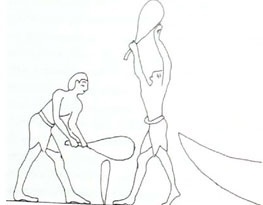 Driving in the mooring post
Driving in the mooring postThe Great Mooring Post, Menit Weret, is a Goddess, She Who calls us to our deaths and Who protects us, moored securely, after death. When we know Her name, She is none other than Isis. “The Mooring Post summons you as Isis,” say the Pyramid Texts, “the Mourning Woman calls to you as Nephthys.” Being called by the Great Mooring Post is a very good thing and ensures the dead will have a stairway to heaven set up for them, among other benefits.
In some cases, a mooring post could serve as a type of pillory to which to bind an enemy for punishment. In a text now in the British Museum, an enemy of Re, Maga, son of Set (make of that what you will), is bound to a mooring post of Osiris. Mooring posts were also part of temple equipment and were used (ritually, I assume) to subdue enemies as well as ensuring ongoing rejuvenation for the Deities of the temple. Overall then, the symbolism of the mooring post as well as the Great Mooring Post, Our Lady Isis, is magical power, stability, and a secure and protected afterlife.
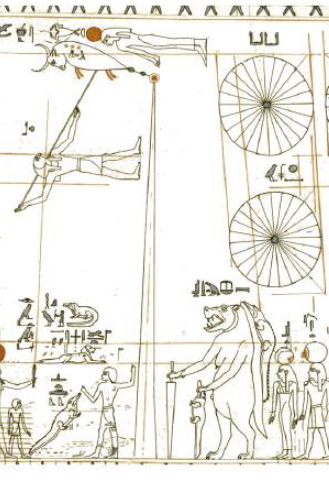 Iset Djamet with mooring post
Iset Djamet with mooring postIn the sky, stars envisioned as mooring posts were also associated with Orion’s belt (and thus with Osiris) as well as with the Imperishable Stars. Both Isis and Nephthys can be connected with mooring posts; indeed, we often see twinned mooring posts illustrated in tombs. The Two Sisters also open the Double Doors of Heaven, which open the way to ongoing rebirth. (Might the Mooring Post Goddesses also serve to keep the heavenly doors open, as a kind of Divine Doorstop?) In the northern sky, the mooring post that anchors the Foreleg of Set is near the north pole, so some Egyptologists suggest that it might have been seen as a kind of divine pivot around which the heavens turn.
In the tomb of Rekmire, an Egyptian noble, we see two mooring posts/Mooring Posts to which or Whom a bull’s foreleg is being offered. A female figure watches as a bull is sacrificed (remember the Kite from several weeks ago?) while two female figures mourn beside the two mooring posts. They are not labeled, but it would make sense if They were Isis and Nephthys or priestesses representing Them. Egyptologist Harco Willems sees this offering to two mooring posts/Mooring Posts as part of the vigil of Osiris.
As we saw last week, the mooring post and the knife are often interchangeable in ancient Egyptian art, and both could be made of flint. Isis Herself IS the Great Mooring Post and She often carries and uses a knife. Sometimes, She uses a knife to fight off the enemies of Re, such as the Great Serpent Apophis. On a more mundane level, flint knives could be used to protect against and treat snakebite. Isis also has a special knife for cutting the birth cord of Horus, the name of which the dead needed to know to proceed in the afterlife. In a myth recorded in the Papyrus Jumilac, Isis shapeshifts into a bitch with a knife at the end of Her tail in order to fight Set. And, as a knife-wielding Goddess, Isis is a warrior—for Deities like Osiris and Re as well as for the king.
 Egyptian flint knife or des
Egyptian flint knife or desArchetypally, Isis’ knife surely would have been the primordial knife, the knife of flint.
Flint & the Flint Knife
Flint is a type of cryptocrystalline quartz that typically forms in sedimentary rocks. It has two very special characteristics. First, it breaks in such a way that very sharp edges can be created—which is why it was used to make the first knives.
Second, because it has a high silica content, it can produce sparks when struck against another hard material, today usually steel, but another hard rock, such as quartz will also work. The Egyptians called it firestone. (Striking sparks with flint and a quartz crystal seems like a pretty dang magical way to start a ritual fire, if you ask me.)
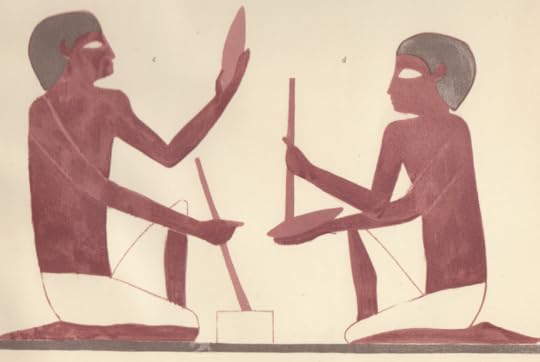 Making flint knives
Making flint knivesFlint, among other minerals, was offered to Osiris as part of His resurrection rites during the Khoiak festival, so we can connect it with that ever-present Egyptian theme, too. Ancient Egyptian flint jewelry has also been found.
In nature, flint is found in nodules which sometimes come in odd shapes that suggest other objects.
Flint is abundant in the Valley of the Kings and Queens. The villagers of Deir el-Madina, who built the tombs there, collected these natural sculptures, sometimes painted them to enhance the design, and offered them in chapels, or even had them embedded in their funereal stelae.
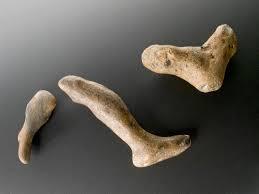 Flint in the shape of a leg and foot; not from Egypt
Flint in the shape of a leg and foot; not from EgyptSome of these similacra looked like pregnant women, a similarity that was emphasized by painting. Other flint nodules suggested various creatures such as crocodiles, serpents, or scarabs, as well as the solar and lunar disks.
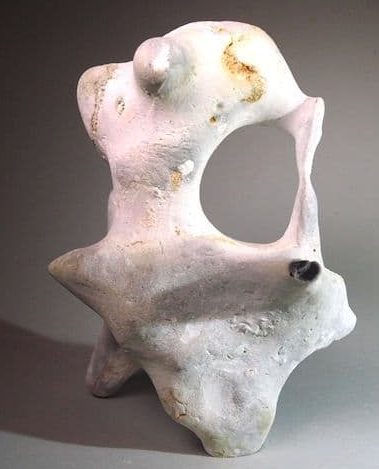 A flint nodule in a dramatic shape; you can see how this one might be enhanced by paint and carving to form a female figure
A flint nodule in a dramatic shape; you can see how this one might be enhanced by paint and carving to form a female figureThe articles I’m reading about ancient Egypt and flints says that, overall, there are several themes associated with the flint simulacra: Emergence and Primeval Creation (because they’re natural sculptures and emerge from the surrounding rock); the Feminine (because of the pregnant woman images, as well as some painted as Nuet, other Goddesses, or lotuses); and the connection between the celestial and underworld realms (because of flint’s emergence from the earth, yet its sharp and fiery nature like the stars).
In the Book of the Dead, a scepter made of flint is associated with the northern sky, wind, and breath; its name is “Breath-Giver.” In the hieroglyphs for this passage, the scepter is shown as a was (“power”) scepter. And the was scepter was associated with Set. Two was scepters were the emblem of His nome of Oxyrhynchus and the head of the scepter itself may be intended to represent the head of the so-called Set beast, a creature as yet not securely identified.
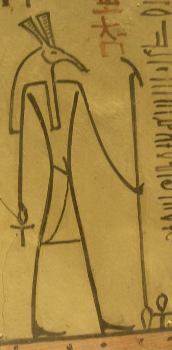 Set with was sceptre
Set with was sceptreAnother flinty connection is with the pesesh-kef, a ritual tool used in the Opening of the Mouth ritual. At least in earlier periods, it was made of flint. The Opening of the Mouth ritual was part of the rebirthing of the dead, but it could also be used to bring life to things like the sacred images in temples. What’s more, the pesesh-kef could also be used to cut the umbilical cord once the child was born, again associating it with birth as well as rebirth.
Flint was often connected with meteoric iron, another Setian material. Flint, like iron, was said to “come forth” from Set. Plutarch, in his essay on Isis and Osiris, notes that the Egyptians say that iron is the bone of Set. And right after writing that, he relates a strange story about Zeus’ (i.e. Amun or Amun-Re’s) legs having grown together so He couldn’t walk. But Isis—surely with Her sacred knife—cut free His legs so He could stride the earth once more.
Fiery Lionesses & Flint
Flint is also connected with the Return of the Wandering Goddess. It was one of the offerings given to appease the Goddess upon Her return. I don’t know, but I wouldn’t be surprised if some of these decorated flint nodules might have been offered as well, especially the woman-shaped ones. As you know, the Returning Goddess may be Hathor, Sakhmet, Tefnut, Bastet—or any of the Goddesses with a lioness or feline form—which means most of Them, including Isis. Flint is sharp like the claws of these Goddesses. Flint is fire-producing, like the very Being of these Fiery Eye-of-Re Goddesses, Who can spit fire or even turn Themselves into frightening infernos.
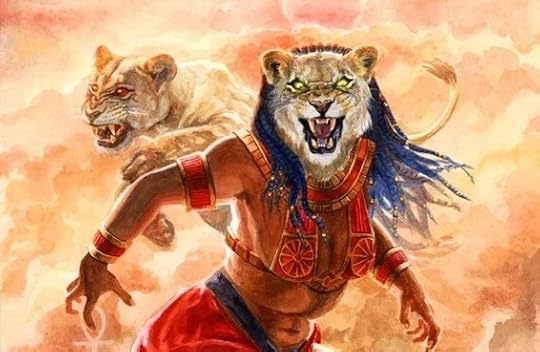
And yet these burning lionesses are also fiercely protective—of Re, of course—but lionesses are known as ferocious protectors of their cubs, just as mother hippos are of their calves.
Now What?
Interesting as all this may be, what can we do with this information in our spiritual and magical work with Isis?
For me, knowing more always gives me more magical tools in my magical toolbox. It provides me with more symbols and aspects of My Goddess to explore in my meditations—which, in turn, always opens additional insights and helps integrate the intellectual with the experiential.
We’re already familiar with a lot of the concepts we’re been discussing: fierce and protective Mother Goddesses, renewal and rebirth, the ancient Egyptian desire for stability and strength, the need to repel and subdue enemies, protective fire, magical fire, and the connection between our world and the Otherworld, both nether and celestial. Personally, I was thrilled to learn about the flint nodules that became natural talismans and offerings for the ancient Egyptians.

Here’s some brainstorming on how we might use this information in our Work with Isis:
Obtain a new magical tool, a knife or “mooring post.” Since the two are fairly interchangeable—and a knife is easier to find and more compact than a mooring post—you could buy or, if you’re crafty, make a flint knife. I might actually name my knife “Mooring Post of Isis” so that I could use it for all the purposes we’ve been discussing, from the stabilizing ability of the mooring post to the defensive capabilities of a knife.
I will definitely be trying to light a ritual fire with flint. (And I might use some flash paper as part of my tinder, as in the Rite of Capturing Sunlight, to ensure success.)
Try using a mooring post/knife to stabilize a spell. Write it down on papyrus and drive the tool through it into the ground, helping it manifest. (You could even do this indoors using a deep bowl of earth.) When the rite is accomplished, release it with proper thanks. You might do the same thing as a protection spell with the name of the enemy (doesn’t have to be a person; an enemy might also be a bad situation), written down and stabbed through.
Use the tool to stabilize yourself. If you’re feeling “unmoored,” go outside and drive the mooring post/knife into the ground. Sit on the earth and let the strength and stability of Isis uphold and support you.
Meditate with Isis, asking Her to more fully explain the mysteries of the mooring post, knife, and flint to you.
Go out on a clear night and look at the Big Dipper and Draco. See Them through the eyes of the ancient Egyptians as the constellation of Iset Reret the Hippopotamus Goddess Who secures and guards the Foreleg of Set. Meditate on what that might mean.
Purchase some flint and consecrate it as a talisman of strength and protection. I’ve even seen flint beads for making jewelry—and with the Egyptian precedent, this would be an easy and beautiful way to carry the powers of flint.
And that’s just the beginning. What ideas do you have for using the magic of flint knives, mooring posts, and the stars in your Work with Isis?
 The fiery, fierce, and sharp Eye of Re Goddess
The fiery, fierce, and sharp Eye of Re Goddess



